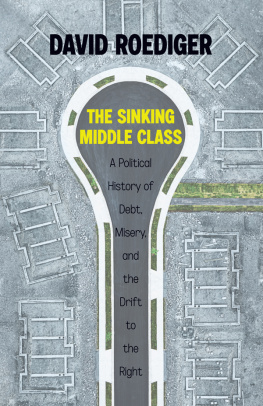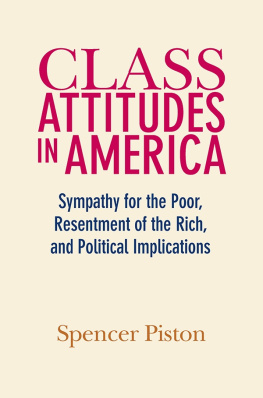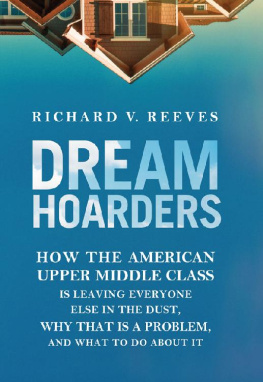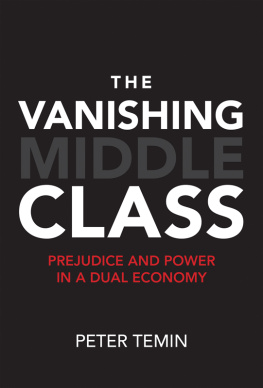Privilege Lost
Privilege Lost
Who Leaves the Upper Middle Class and How They Fall
JESSI STREIB


Oxford University Press is a department of the University of Oxford. It furthers the Universitys objective of excellence in research, scholarship, and education by publishing worldwide. Oxford is a registered trade mark of Oxford University Press in the UK and certain other countries.
Published in the United States of America by Oxford University Press
198 Madison Avenue, New York, NY 10016, United States of America.
Oxford University Press 2020
All rights reserved. No part of this publication may be reproduced, stored in a retrieval system, or transmitted, in any form or by any means, without the prior permission in writing of Oxford University Press, or as expressly permitted by law, by license, or under terms agreed with the appropriate reproduction rights organization. Inquiries concerning reproduction outside the scope of the above should be sent to the Rights Department, Oxford University Press, at the address above.
You must not circulate this work in any other form and you must impose this same condition on any acquirer.
Library of Congress Cataloging-in-Publication Data
Names: Streib, Jessi, author.
Title: Privilege lost : who leaves the upper middle class and how they fall / by Jessi Streib.
Description: New York, NY : Oxford University Press, [2020] | Includes bibliographical
references and index.
Identifiers: LCCN 2019042460 (print) | LCCN 2019042461 (ebook) |
ISBN 9780190854041 (hardback) | ISBN 9780190854058 (paperback) |
ISBN 9780190854072 (epub) | ISBN 9780190854089
Subjects: LCSH: Marginality, SocialUnited StatesHistory. | Downward mobility (Social sciences)
United StatesHistory. | YouthUnited StatesHistory. | Middle classUnited StatesHistory. |
WhitesRace identityUnited StatesHistory.
Classification: LCC HM1136 .S78 2020 (print) | LCC HM1136 (ebook) |
DDC 305.5/130973dc23
LC record available at https://lccn.loc.gov/2019042460
LC ebook record available at https://lccn.loc.gov/2019042461
Contents
Privilege Lost
Julies story is one that social scientists and journalists commonly tellone of upper-middle-class youth becoming upper-middle-class adults. Yet, Veras trajectory diverged from Julies. After finishing high school, Vera attended a community college and planned to later transfer to a four-year college. She acquired an associates degree, but, at age 28, she had not obtained a bachelors degree and no longer thought she would. She became an office assistant and married a high-school-educated electrical lineman. Her story was one of downward mobilityshe entered adulthood in a lower social class than the one she was born into as a child.
What Is Downward Mobility?
If the class structure resembles a pyramid, those in the upper-middle class are part of a narrow band near the top. A four-year college degree and professional job define membership in this social class, and only about one in five white American children have at least one parent with these statuses. Being born near the top of the class structure has many advantages, but it also has another important feature: there is plenty of room to fall.
Downward mobility refers to fallingmoving from a higher to a lower social class. It is a neutral descriptornot a moral or negative one. There are many types of downward mobility. This book focuses on one: intergenerational, absolute downward mobility from the upper-middle class. Intergenerational downward mobility refers to adult children entering a lower social class than their parents occupied as adults. As childrens class position is defined by their parents class position, intergenerational downward mobility also refers to entering a lower social class as an adult than the class individuals were raised in as a child. Intergenerational mobility is measured in what social scientists call an absolute way when it refers to children entering a lower social class than their parents, regardless of how they or their parents rank compared with their peers in their generation.
Of course, class positions can change, and some argue that they are especially prone to do so shortly after the transition to adulthood. Thus, contrary to folklore, the transition to adulthood is not a time of inconsequential explorationeven for those born into the upper-middle class. Rather, it sets youth on trajectories that most do not leave.
The Numbers
For youth born in the 1980s, the most common way to enter the upper-middle class as an adult was to be born into it as a child. However, among this cohort, downwardly mobile trajectories were common too.
Downward mobility is then routine. Part of the reason relates to the number of slots in the upper-middle classthe number of students colleges admit, the number of professional jobs, and the number of college-educated professionals available to marry.
However, the labor market did not maintain so many professional positions for youth born in the 1980s. This cohort was new to the labor force when the Great Recession hita time when employers took down job ads, layoffs rose, and competition for jobs increased.
Moreover, for youth born in the 1980s, it was becoming more difficult to secure a spot in the upper-middle class through marriage. Compared with the past generation, a larger portion of upper-middle-class workers chose other upper-middle-class workers as their spouse; marrying laterally by social class became more common and marrying up by social class became harder to do.
The number of professional jobs and marriage partners helps explain why staying in the upper-middle class is difficult to doeven for youth born into it. However, knowing this tells us little about who is apt to fall, how they fall, and why they dont see it coming. The latter questions are the focus of this book. To answer them we need to study downward mobility in a new way.
Who Falls and How
Below is an overview of how we can think about who falls and how; the following chapters provide concrete tales that adhere to this account. The overview first describes the frameworks two main conceptsinherited resources and identitiesas well as each of their subparts. It then explains how inherited resources and identities relate to downward mobility. Of course, this new framework does not capture all reasons for downward mobility, describe all upper-middle class youths lives, or allow us to be certain that a particular person will be downwardly mobile. It does, however, describe the lives of the majority of youth in the sampleand likely a majority of white upper-middle-class Americans class trajectories too.
Inherited Resources
To understand who falls, we need to understand youths inherited resources. Each upper-middle-class youth is raised with a set of inherited resourcesa constellation of economic capital (money), human capital (academic knowledge and skills), and cultural capital (knowledge of how to navigate institutions) These resources then matter because they help youth become college-educated professionals and marry themthey help youth remain in the upper-middle class.
Of course, not all upper-middle-class parents possess equal amounts of each resource. Parents earnings vary, even within the upper-middle class. Nonprofessionals occupations give them less human and cultural capital, and, for those without four-year college degrees, their educations confer less human and cultural capital too.











